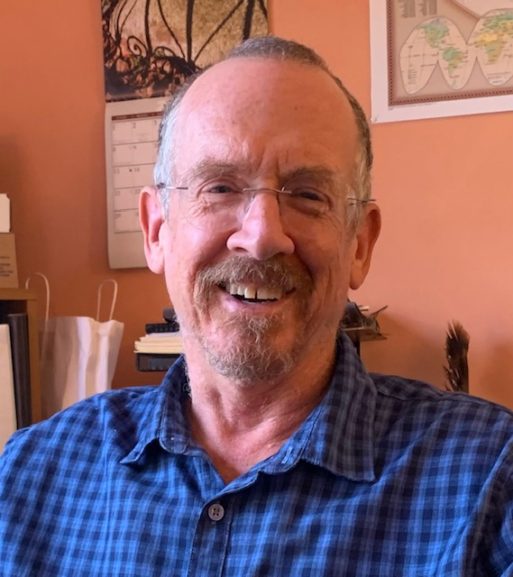
Scott Janssen: “Being fully present is one of the most important things we can do for someone with PTSD at end of life.”
Scott Janssen, MA, MSW, LCSW is a social worker with the University of North Carolina Hospice and a member of the National Hospice and Palliative Care Organization’s Trauma-Informed Care Work Group. Janssen’s articles have been published in dozens of media outlets including The Journal of Palliative Medicine, Washington Post, HuffPost, and Readers Digest. Janssen has also written a fiction-based novel relevant to end-of-life experiences: Light Keepers and a nonfiction book, Standing at Lemhi Pass.
Editor’s note: this interview has been edited for length and clarity
Most of us are familiar with the term PTSD, or Post Traumatic Stress Disorder, in relation to military veterans. But how might anyone be affected by PTSD?
If you think about all the ways in which symptoms of PTSD may arise, you realize that we all may be susceptible to it.
One of the essential ingredients of PTSD is that someone has survived an experience in which they were, or they believe they were at risk of death. Of course, that happens in combat. But it also happens in car accidents, injuries, assaults or even medical trauma, which can result from situations when someone needed emergency surgery or intensive care. Sometimes it is not a single event or situation. Trauma can gradually develop from being exposed to chronic threats like verbal or emotional abuse; anything that undermines someone’s safety.
PTSD can also be caused by witnessing someone in a life-threatening situation or witnessing someone die. If you witness violence in some way, you could potentially walk away with PTSD. This is known as secondary traumatic stress or vicarious PTSD. For example, first responders and those in the medical field often witness these kinds of situations and not surprisingly levels of post-traumatic stress tend to be higher in these professions.
What does PTSD look like?
PTSD rewires a person’s nervous system into a constant state of flight, fright, and freeze. This is what happens when someone perceives a threat. With PTSD, the body continues to respond to a threat that lives in the past. and is on guard for anything reminiscent of a traumatic event. These triggers can be anything even remotely associated with the original trauma: a taste, a smell, a sound, temperature, images or emotions.
There are four dimensions in which PTSD symptoms can occur in some kind of combination. It does not always present the same for everyone, but these are a good guide for anyone to recognize the signs of PTSD in someone:
- Re-experiencing or reliving traumatic experiences: flashbacks or nightmares or intrusive memories that push their way into your awareness.
- Trauma-related arousal or hyper reactivity symptoms: things like hypervigilance when someone is constantly on guard scanning for danger in their surroundings and feeling unsafe. There may be exaggerated startle response, insomnia, difficulty concentrating and reduced frustration tolerance.
- Avoidance symptoms: avoiding anything that may cause them stress or stressful situations and undermine social support.
- Negative thoughts and feelings about oneself or the world: overly negative beliefs, catastrophic thinking or expectations about the future, exaggerated sense of blame to self or others, shame, difficulty feeling positive emotions like joy or happiness.

Scott at home spending time with his buddies, Shilo and Aya
How common is PTSD at End of Life?
I think it is at least as common at end of life as it is in the general population, but perhaps more so. In general, about 7% of the population at any given time has PTSD. Research suggests that more than 50% of adults will experience some sort of potentially traumatic experience in their lives that could lead to post-traumatic stress of some kind.
As we get older, our chance of having a traumatic or post-traumatic event increases. We are more likely to lose a spouse or loved one, develop a debilitating illness and need invasive medical care. Healthcare settings can be impersonal and dehumanizing. People can feel a loss of privacy or loss of control and that can be terrifying for those who may be harboring a previous traumatic experience. Physical symptoms like shortness of breath, pain or cognitive changes can also undermine our personal sense of safety.
If you have these kinds of elements in play and then throw in a terminal diagnosis, it can trigger symptoms of PTSD. For some, it could even cause delayed onset PTSD.
PTSD triggers at end of life may include things like a loss of meaningful roles or routines, a sense of helplessness, ruptures in personal boundaries, relocation, immobility, medication effects, perceived differentials in power between patient and staff, symptoms associated with disease progression, an impaired ability to make their needs known and facing one’s own mortality.
You mention in some of your articles that “being fully present” with someone experiencing PTSD is the most valuable thing anyone can do for someone at that moment. What do you mean by that?
Being fully present means that you are a loving, non-judgmental presence.
When someone is suffering, there are simple things we can do to provide comfort to them. Listening in a non-judgmental way, showing kindness and acceptance, and making a connection allow a person to feel the way they feel. As we listen, we may be able to reconnect them with their strengths and creativity.
Being present also means we allow ourselves to accept our own humanness. We are all beautifully imperfect humans. If we lose our patience or get frustrated, we can take a moment to bring ourselves back to the present moment. Take a breath; refocus your attention. Remind yourself that simply being present with someone who is hurting is a powerful expression of love and solidarity, bearing witness, and building trust. These are the things that can create the healing energy for the patient, as well as the caregiver.
What can caregivers do to better assist their loved one struggling with symptoms of PTSD at end of life?
When someone is approaching death, many will have an impulse to reflect on and take stock in their lives. Some may want to share memories or stories. This can bring patients and families a sense of bonding or joy. But if those memories are painful in some way, it can have a negative effect on patients and/or their families, and even lead to anxiety, sadness, guilt, shame or remorse. This may even complicate the dying process, impeding the patient’s ability to accept necessary care and comfort measures.
Caregivers might identify things in the environment causing their loved one’s stress. In our efforts to be reassuring, we may too easily dismiss our loved one’s concerns, “Don’t worry about that, dad.” Or “I will handle that, mom.” If someone has a concern, we can take it seriously, try to be patient, and recognize their underlying needs. We validate it and then attempt to address it.
We can learn what helps to calm our loved ones when they get stressed out. Perhaps it is as simple as leaving a door ajar, turning on a nightlight, playing some favorite music, or altering routines in some small way. And we can give our loved ones as much choice in their day-to-day life as is practical or possible.

Janssen frequently lectures to professional colleagues on patient PTSD, end-of-life care for veterans, and transpersonal experiences.
Are there professional resources available to families that need additional support at home, in a hospital or within a facility where their loved one resides?
Unfortunately, medical professionals don’t always recognize the signs of PTSD at end of life. Patients often do not disclose trauma histories due to shame, fear of stigma or a desire to avoid painful memories. PTSD can be misdiagnosed or go unrecognized. Some patients may be labeled as mentally ill, in denial, or non-compliant. Some professionals might even develop negative feelings toward the patient, stigmatizing them, or dismissing their concerns. Hospice or medical staff are not typically trained to recognize PTSD.
In some ways, hospice professionals are the “last” responders. We may be the last group of professionals with the honor of being able to help people heal or find perspective on traumatic wounds before they die. Whether we are aware of a trauma history or not we can always bring in our love and compassion to best assist any patient at end of life. That’s the power of trauma-informed care. It works for everyone. And it also opens our hearts.
The responsibility is ultimately on us, the professional caregivers, to raise our standards. Organizations can take initiative to recognize and respond to signs of PTSD. The United States Substance Abuse and Mental Health Services Administration provides key ingredients for successful trauma-informed care implementation. When empowered, caregivers can seek to actively resist re-traumatization for patients with PTSD.

 End-of-Life PTSD is More Common Than You Think
End-of-Life PTSD is More Common Than You Think


 Our Annual Seven Holiday Gifts for Someone Who Is Grieving, 2024 Edition
Our Annual Seven Holiday Gifts for Someone Who Is Grieving, 2024 Edition
 “Making Mobiles” by Karolina Merska
“Making Mobiles” by Karolina Merska
 “Hands Up to the Sky” by Michael Franti & Spearhead
“Hands Up to the Sky” by Michael Franti & Spearhead















Wonderful article
Report this comment
Your article sheds light on an important and often overlooked topic, bringing awareness to the experiences of individuals who suffer from post-traumatic stress disorder (PTSD) at the end of life. Thank you for discussing the various factors that can contribute to end-of-life PTSD, such as traumatic medical interventions, witnessing suffering, or experiencing a sudden decline in health. Your article helps to normalize and validate the feelings and struggles faced by individuals who are nearing the end of their lives.
Report this comment
Thank you Lindsay for your thoughts regarding a difficult topic. We work to cover many aspects of PTSD to educate others. We appreciate your input and support.
Report this comment